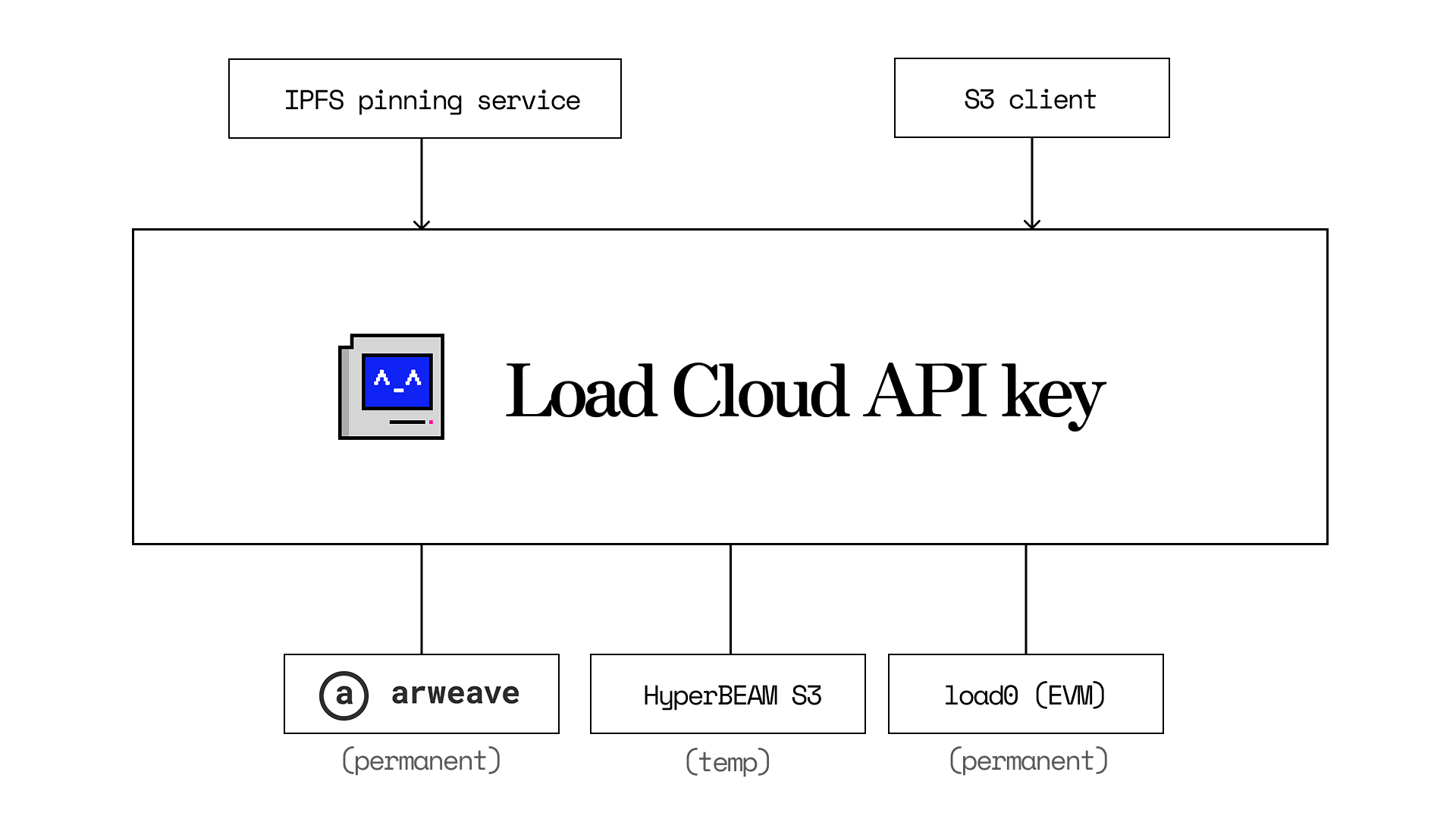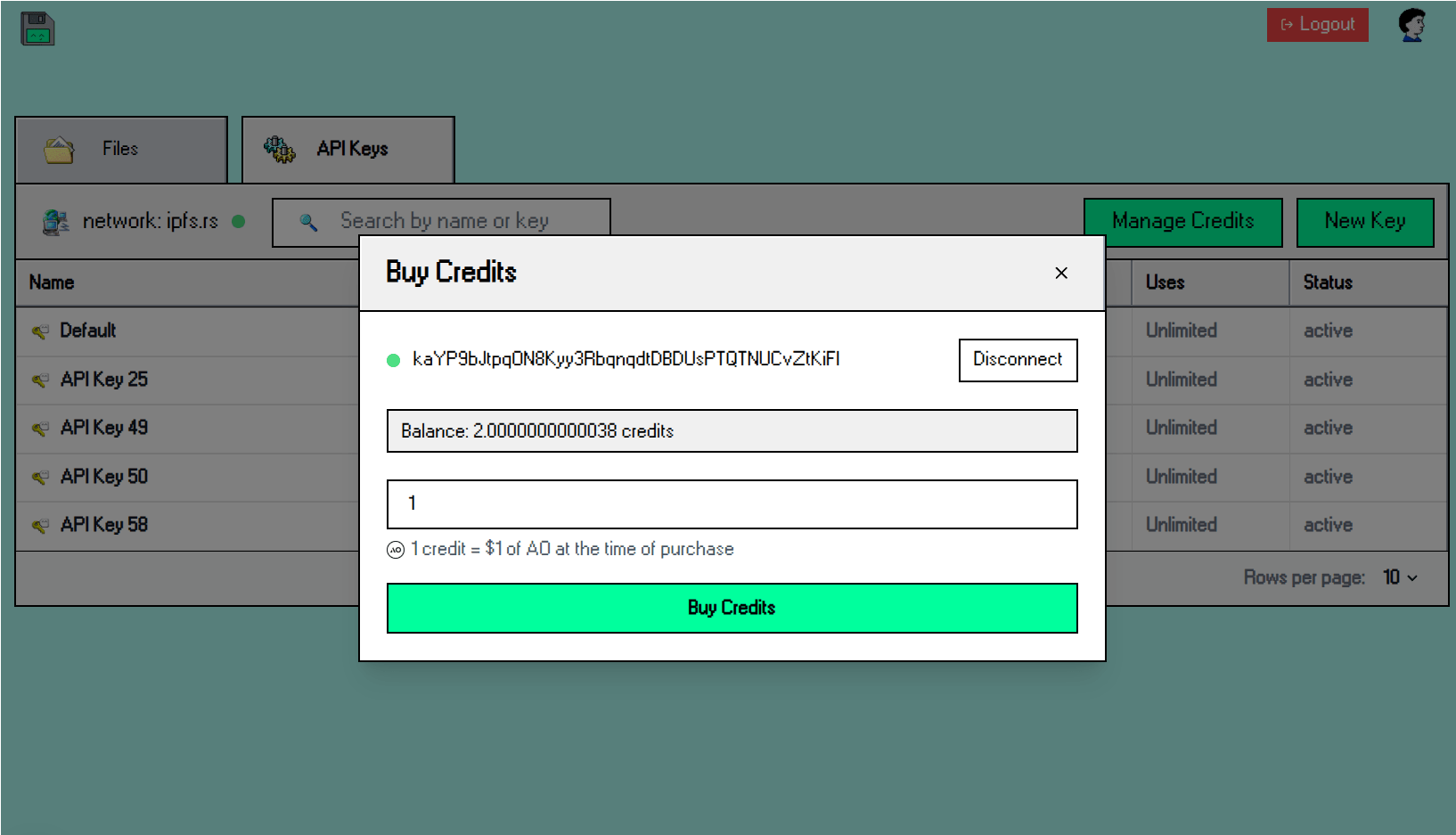Most web3 applications still run on AWS with a thin blockchain layer on top, choosing a few user-facing blockchain concepts and handling the rest offchain.
We want the power of web3 without killing adoption potential with horrendous UX. It’s an infrastructure problem. Today, if you want to build a serious application, you face a tough choice:
Option 1: Traditional Cloud (AWS, Google Cloud)
- Fast, reliable, easy to use
- But centralized, expensive, and your data disappears if you stop paying
- Vendor lock-in, censorship risk, and no real data ownership
Option 2: Existing Blockchain Infrastructure
- Decentralized and permanent
- Higher barrier to entry for developers and users
- Permanent and costly, or temporary with questionable guarantees
- You’re pushing confusing gas fees and wallets on users
The Solution: What if AWS Was Decentralized?
Clouds like AWS and GCP consist of:
- Compute: Traditionally, this is virtual machines – docker, VMs, serverless functions. For Load, it’s EVM smart contracts, HyperBEAM devices, and AO processes.
- Storage: Usually an S3 bucket. For Load, it’s Arweave, Load EVM calldata, and an incentivized temporary storage network with full S3 compatibility.
We’re building the onchain data center - blockchain infrastructure that works exactly like the cloud services you already use, but with the benefits of decentralization and permanence.
Same APIs, same developer experience, fundamentally different backend.
Let’s make it tangible straight away. Here’s an example you can use today with Load’s S3 client. Want to migrate from AWS S3? Just change your endpoint.
import { S3Client } from "@aws-sdk/client-s3";
const accessKeyId = process.env.LOAD_ACCESS_KEY;
const secretAccessKey = ""; // It's meant to be empty
const s3Client = new S3Client({
region: "eu-west-2", // Required -- current supported region
endpoint: "https://s3.load.rs", // Load.Network S3 endpoint
credentials: {
accessKeyId,
secretAccessKey,
},
forcePathStyle: true, // Required
});Your existing code hardly changes, but now your data is able to be made permanent onchain with a pay-once-store-forever model. It’s able to flow into an EVM system so smart contracts can interact with your data, and then to Arweave for permanence guarantees. And storage is actually cheaper than AWS while it sits in the temporary cache layer – we’re targeting 7.7x less than AWS.
How We Made This Possible
Building onchain infra that matches traditional cloud performance needs a new kind of stack.
The Alien Stack
- Native Arweave integration in our EVM layer creates the first programmable permanent data
- Modular EVM components powered by ao-HyperBEAM devices for hyperscalable compute
- Bidirectional data pipelines between Arweave/AO and the EVM layer
- Custom transaction formats optimized for data-heavy applications (0xbabe)
Web2-like performance
- 62 MBps throughput in our current testnet (Alphanet v5)
- 150 MBps blobspace bandwidth in development
- Cost-efficient permanent storage through custom EVM-Arweave gaseconomics
What You Can Build Today
Load Cloud Platform (LCP)
The Load Cloud platform gives you familiar interfaces to blockchain infrastructure:
IPFS Pinning Service (ipfs.rs)
- Drop-in replacement for existing IPFS pinning services
- Same SDKs, same workflows, permanent storage backend (via Arweave & Load)
S3-Compatible Storage (s3.load.rs)
- Use existing S3 SDKs and tools
- Migrate existing applications with minimal code changes
Storage Options for Every Use Case
Permanent Storage (pay once, store forever)
- Load0: Programmable permanent data on Arweave with EVM integration
- Turbo: Direct Arweave storage via ARIO bundling
Temporary Storage (coming soon)
- HyperBEAM nodes: Rent storage space by the month
- Token payments: Pay in AO-based tokens for storage terms
Choose permanent storage for data that needs to last (user uploads, NFT metadata, app assets). Use temporary storage for caching, logs, and other ephemeral data.
Flexible compute options
We built Load Network to expose the EVM standard to Arweave storage. With the EVM’s low storage capacity and extreme pricing, the world computer was missing a hard drive, and we saw Arweave filling that gap. EVM compute will always be available on Load Network as it’s unique edge, but in its onchain data center era, we unlock AO and HyperBEAM:
- Load’s core compute layer: the EVM. Deploy EVM smart contracts that interface with Arweave via precompiles, breaking the storage barrier and unlocking data-intensive dApps
- General purpose devices: AO processes. Load’s EVM and storage devices are callable from inside AO processes, which can act as typical web2 microservices with web3 powers.
- Serverless function runtimes: Load HyperBEAM devices. HyperBEAM enables novel compute layers to be brought inside the AO paradigm and made interoperable. We have already built a GPU compute layer that enables WGSL processes, and a quantum compute-ready device. The openness of HyperBEAM means that practically anything can be turned into a device and added to the Load-AO stack.
The Economics: $AO Powers Everything
Instead of traditional billing:
- Buy credits with $AO tokens (no monthly bills)
- Pay for storage and compute with the same account
- Node operators earn $LOAD for providing storage and compute
This creates a sustainable economic model where users pay for what they use, operators earn from providing resources, and everyone benefits from network effects.
The Vision: Complete Cloud Replacement
This is just the beginning. We’re building toward a complete decentralized cloud platform:
Phase 1 (now): Storage and data pipelines
- S3, IPFS and Arweave compatibility
- Permanent and temporary storage options
- $AO-based credits system
Phase 2 (in progress): HyperBEAM storage and compute abstraction
- Build on an incentivized temporary storage network
- Operate an optimistic Load S3 storage provider in HyperBEAM
- Pay for EVM compute with cloud credits
Phase 3 (SOON): Complete data center
- Unifying all storage and compute options with native cross-interoperability
- Hardware upgrade of the Load storage provider to 1PB
- Decentralized bundler network for data onboarding, powered by ao-Hyperbeam and reliant on the Load S3 network.
- SP compatibility for other networks, like Greenfield, to expose Arweave permanence to other ecosystem
Why This Matters
The onchain data center is about creating infrastructure for a different kind of internet:
- Applications that can’t be shut down (permanent storage, decentralized hosting)
- Data that users actually own (not just “stored” somewhere mysterious)
- Developers who aren’t victims to platform rent-seeking (predictable costs, no vendor lock-in)
- Innovation that doesn’t require permission (open protocols, not closed APIs)
Every code commit from our team brings us closer to this reality. The onchain data center is taking shape today, with a roadmap to replace traditional cloud entirely, with a user-owned model and sensible open standards.
The onchain data center is inevitable.


